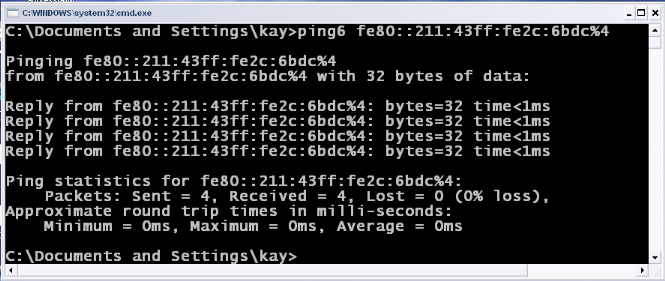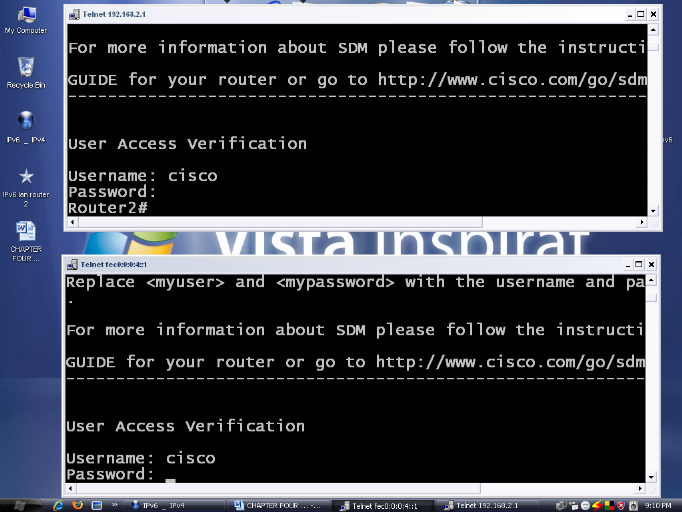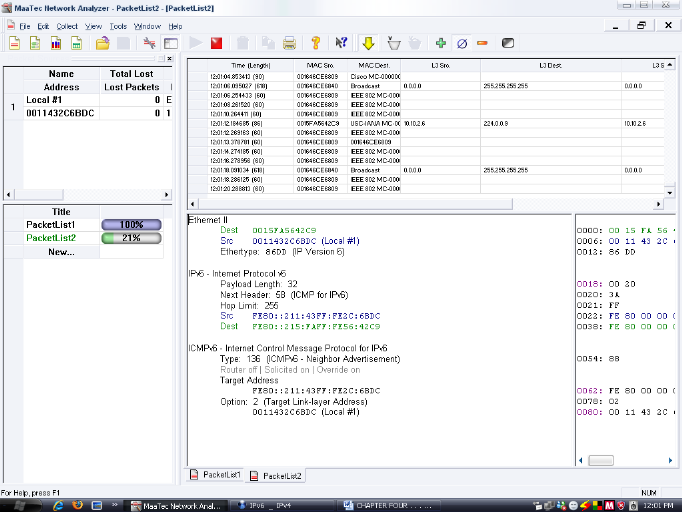IV.5 TEST and ANALYSIS
The purpose of this step is to provide information about how
to make a network; configure and test IPv6 protocol functionality and its
features.
During the testing, we tested with minimum number of
computers. Individual computers have been used to clearly show the QoS and the
performance. The configuration, including IP addresses and all other
configuration parameters. This network test lab has been tested on a separate
network and services provided on the network to avoid the impact of the test on
the network.
The following illustration shows the configuration of the
Network test lab.

Figure 8: Network test-lab
diagram
Source: Own drawing
We made this Network test lab by configuring two routers with
both version of IP in order to forward and route packets across clients in this
network. The configuration procedure is given in the Appendix.
We installed IPv6 on the side of clients and assigned
statically the IPv4 addresses arranged in the appropriate network. The
installation is shown in the next section IV.6.
IV.5.1 Ping Results of Network
test lab
Our Network test lab ping results were to test the
connectivity between work-stations that are in the network. Testing the
connectivity between work-stations by using IPv4 addresses were different from
using IPv6 addresses.
Testing the connectivity between work-stations that are
assigned with IPv4 address can only be tested by using only one address but
with IPv6 address the connectivity can be tested with many addresses for
example pinging with IPv6 link local address, IPv6 site-local address, IPv6
addresses with embedded IPv4 addresses.
This is one of option that was upgrade to the IPv4, which is
one of QoS the devices that support IPv6 can have multiple addresses.

Figure 9: Ping IPv4
address
Source: Output Print Screen of ping IPv4

Figure 10: Ping6 IPv6
site-local
Source: Output Print Screen of Ping6
site-local

Figure 11: Ping6 IPv6
link-local address
Source: Output Print Screen of Ping6
link-local

Figure 12: Ping6 IPv6
embedded IPv4 address
Source: Output Print Screen result of IPv6 embedded IPv4
address
As show in the figures below (figure 10, 11, 12); the TTL has
been removed in ICMP packets which can allow ICMPv6 packets to pass quickly
trough the network, and it can also allow ICMPV6 packets to test the
connectivity without dying until it reach its destination.
IV.5.2 Netwrok test lab Telnet
results
As we set a network that include both IP (a dual-stack); we
tested with telnet by specifying the IPv4 or IPv6 address of the remote
computer to connect to. From the telnet results, we were able to reach the
nodes of router or computer connects to. 
Figure 13: Telnet
IPv6/IPv4
Source: Output of Print Screen of Telnet
IV.5.3 Network test lab
Analysis
The Maa Tec Network analyzer has been used during testing the
Network test lab
IV.5.3.1 IP packets test

Figure 14: The packets
list.
Source: MaaTec Network analyzer/ Packet list
The figure above displays detailed information about the
packets. In the packets list, there columns that display information about time
and length of the collected packet, the network devices, Media Access Control
(MAC) address of the sender or receiver of the packet, the OSI layer of source
or destination source of the packet, type of service.
We selected among the packets captured in the layer column
where IP laid. The layer 3 (network layer) of OSI model provided the
information about the IP header of the system that sent or receive a packet and
we compared both IP headers format.
|
IPv6 Packet
|
IPv4 Packets
|
|
IPv6 - Internet Protocol v6
Ver|DS|Flow: 60000000
Version: 6
Traffic Class: 0
Flow Label: 0
Payload Length: 40
Next Header: 58 (ICMP for IPv6)
Hop Limit: 64
Src FE80::211:43FF:FE2C:BF3C
Dest FE80::211:43FF:FE2C:6BDC
|
IPv4 - Internet Protocol v4
Ver/IHL: 45
Ver: 4 Header Length: 5 (20 bytes)
Type of Service: 00
Precedence: 0 (Routine)
normal delay | normal throughput | normal reliability
Total Length: 60
Identification: 341
Fragmentation: 0000
may fragment | last fragment
Fragment Offset: 0
Time to Live: 128
Protocol: 1 (Internet Control Message)
Checksum: 45819
Src 192.168.2.21
Dest 192.168.3.11
|
Table 4: IPv6 and IPv4 Header
packet
Source: Maa Tec Network Analyzer
As shown in the table above the packets format is passing on
the same port and the way IPv6 packets are forwarded by paths are different
from those for IPv4.
This way IPv6 packets passes allow packets to pass quickly
trough routers.
As there is change in design of IP, the new one carries a
number of QoS. In IP header there is a good example of the features of QoS. The
header of IPv6 is simplified; it does not have many fields to be checked.
This QoS can provide to a network to be fast when packets are
traveling through the network.
| 


